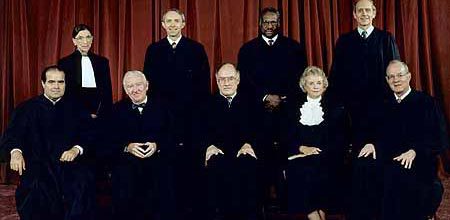Americans with Disabilities Act
Categories: Civil Rights
The Americans with Disabilities Act (ADA), as amended by the ADA Amendments Act of 2008 (Public Law 110-325), prohibits discrimination of individuals with disabilities in employment, public services, public accommodations, and telecommunications. President George H.W. Bush signed the ADA into law on July 26, 1990. The ADA Amendments (ADAAA) of 2008, signed into law by President George W. Bush on Sept. 25, 2008, was enacted in response to a number of decisions by the U.S. Supreme Court that were viewed as limiting the rights of persons with disabilities.
The ADAAA clarified and broadened the definition of disability and, therefore, expanded the number and types of people who are protected under the law and other federal disability nondiscrimination laws. The amendments retained the basic definition of “disability” as a physical or mental impairment that substantially limits one or more major life activities, a record of such an impairment, or being regarded as having such an impairment. The law does not list all the types of disabilities that are covered. The ADAAA requires courts to interpret nondiscrimination laws by focusing on whether or not the covered entity has discriminated rather than whether or not the individual seeking the law’s protection has an impairment that fits within the technical definition of the term “disability.”
The key provisions of the law are as follows:
Title I – Employment
- Designed to help people with disabilities access the same employment opportunities and benefits available to people without disabilities.
- Applies to employers with 15 or more employees.
- Requires employers to provide reasonable accommodations to qualified applicants or employees. A “reasonable accommodation” is a change that accommodates employees with disabilities without causing the employer “undue hardship” (too much difficulty or expense).
- Defines disability, establishes guidelines for the reasonable accommodation process, addresses medical examinations and inquiries, and defines “direct threat” when there is risk of substantial harm to the health or safety of the individual employee with a disability or others.
- Regulated and enforced by the U.S. Equal Employment Opportunity Commission.
Title II – Public Services: State and Local Government
- Prohibits discrimination on the basis of disability by “public entities,” which are programs, services and activities operated by state and local governments.
- Requires public entities to make their programs, services and activities accessible to individuals with disabilities.
- Outlines requirements for self-evaluation and planning; making reasonable modifications to policies, practices, and procedures where necessary to avoid discrimination; identifying architectural barriers; and communicating effectively with people with hearing, vision and speech disabilities.
- Regulated and enforced by the U.S. Department of Justice.
Title III – Public Accommodations and Services Operated by Private Entities
- Prohibits places of public accommodation from discriminating against individuals with disabilities. Public accommodations include privately-owned, leased or operated facilities like hotels, restaurants, retail merchants, doctor’s offices, golf courses, private schools, day care centers, health clubs, sports stadiums, movie theaters, and so on.
- Sets the minimum standards for accessibility for alterations and new construction of commercial facilities and privately owned public accommodations. It also requires public accommodations to remove barriers in existing buildings where it is easy to do so without much difficulty or expense.
- Directs businesses to make “reasonable modifications” to their usual ways of doing things when serving people with disabilities.
- Requires that businesses take steps necessary to communicate effectively with customers with vision, hearing, and speech disabilities.
- Regulated and enforced by the U.S. Department of Justice.
Title IV – Telecommunications
- Requires telephone and Internet companies to provide a nationwide system of interstate and intrastate telecommunications relay services that allows individuals with hearing and speech disabilities to communicate over the telephone.
- Requires closed captioning of federally funded public service announcements.
- Regulated by the Federal Communications Commission.
Title V – Miscellaneous Provisions
- Contains a variety of provisions relating to the ADA as a whole, including its relationship to other laws, state immunity, its impact on insurance providers and benefits, prohibition against retaliation and coercion, illegal use of drugs, and attorney’s fees.
- Provides a list of conditions that are not considered to be disabilities, including pregnancy, homosexuality, kleptomania, compulsive gambling, and others.
Transportation
- Public Transportation offered by a state or local government is covered by Title II of the ADA. Publicly funded transportation includes, but is not limited to, bus and passenger train (rail) service. Rail service includes subways (rapid rail), light rail, commuter rail, and Amtrak.
- If transportation is offered by a private company, it is covered by Title III. Privately funded transportation includes, but is not limited to, taxicabs, airport shuttles, intercity bus companies, such as Greyhound, and hotel-provided transportation.
- Regulated by the Department of Transportation, Federal Transit Administration.
Reference: ADA Frequently Asked Questions by Category



